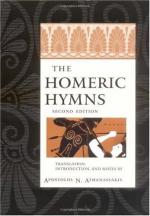He makes, perhaps, a more plausible case for his reduction of dread Persephone to a Pig. The process is curious. Early agricultural man believed in a Corn Spirit, a spiritual essence animating the grain (in itself no very unworthy conception). But because, as the field is mown, animals in the corn are driven into the last unshorn nook, and then into the open, the beast which rushed out of the last patch was identified with the Corn Spirit in some animal shape, perhaps that of a pig; many other animals occur. The pig has a great part in the ritual of Demeter. Pigs of pottery were found by Sir Charles Newton on her sacred ground. The initiate in the Mysteries brought pigs to Eleusis, and bathed with them in the sea. The pig was sacrificed to her; in fact (though not in our Hymn) she was closely associated with pigs. “We may now ask . . . may not the pig be nothing but the Goddess herself in animal form?” {64a} She would later become anthropomorphic: a lovely Goddess, whose hair, as in the Hymn, is “yellow as ripe corn.” But the prior pig could not be shaken off. At the Attic Thesmophoria the women celebrated the Descent and Ascent of Persephone,—a “double” of Demeter. In this rite pigs and other things were thrown into certain caverns. Later, the cold remains of pig were recovered and placed on the altar. Fragments were scattered for luck on the fields with the seed-corn. A myth explained that a flock of pigs were swallowed by Earth when Persephone was ravished by Hades to the lower world, of which matter the Hymn says nothing. “In short, the pigs were Proserpine.” {64b} The eating of pigs at the Thesmophoria was “a partaking of the body of the God,” though the partakers, one thinks, must have been totally unconscious of the circumstance. We must presume that (if this theory be correct) a very considerable time was needed for the evolution of a pig into the Demeter of the Hymn, and the change is quite successfully complete; a testimony to the transfiguring power of the Greek genius.
We may be inclined to doubt, however, whether the task before the genius of Greece, the task of making Proserpine out of a porker, was really so colossal. The primitive mind is notoriously capable of entertaining, simultaneously, the most contradictory notions. Thus, in the Australian “Legend of Eerin,” the mourners implore Byamee to accept the soul of the faithful Eerin into his Paradise, Bullimah. No doubt Byamee heard, yet Eerin is now a little owl of plaintive voice, which ratters warning cries in time of peril. {65} No incongruity of this kind is felt to be a difficulty by the childlike narrators. Now I conceive that, starting with the relatively high idea of a Spirit of the Grain, early man was quite capable of envisaging it both spiritually and in zoomorphic form (accidentally conditioned here into horse, there into goat, pig, or what not). But these views of his need not exclude his simultaneous belief in the Corn Spirit as a being anthropomorphic,




